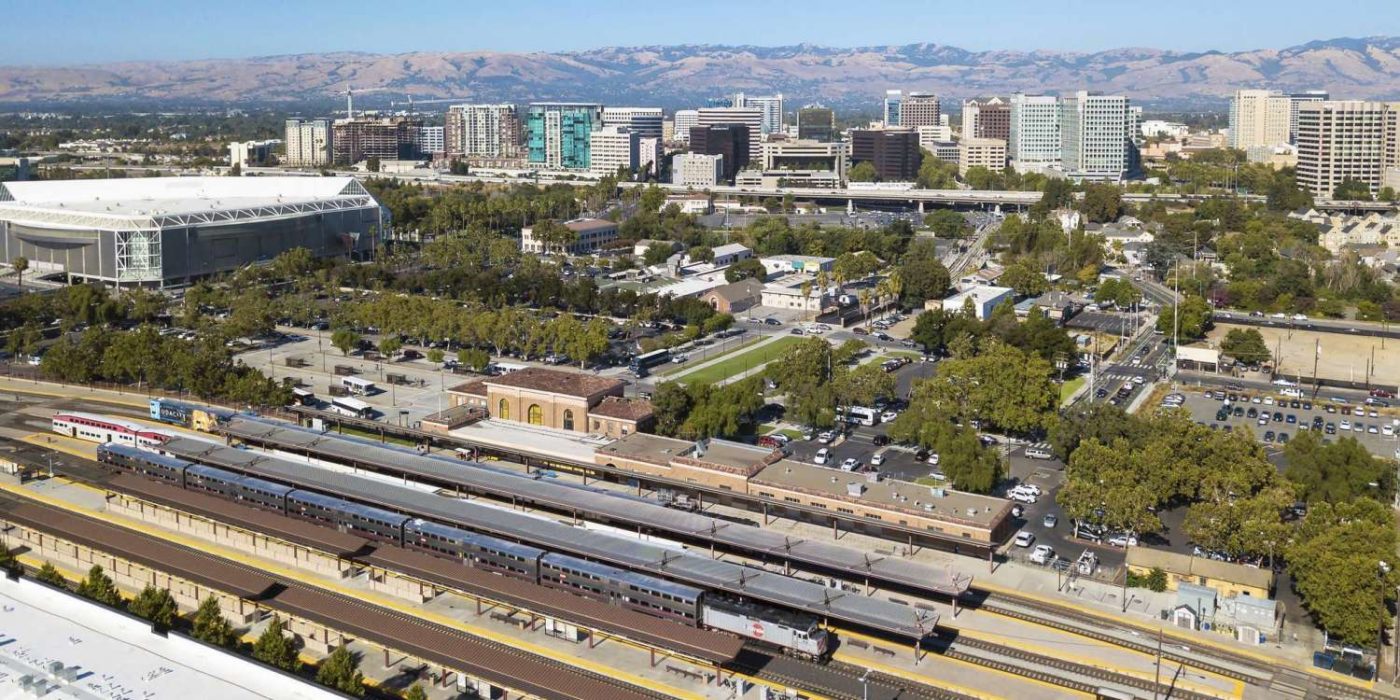SV@Home is excited about the potential for a vibrant, mixed-use Diridon Station Area and the opportunities created for the City’s Downtown San Jose vision, which includes the potential for 60-75,000 new jobs. With Diridon’s prime location adjacent to a multi-modal transit station– that will one day include BART and potentially High Speed Rail– there is a significant opportunity to create high density housing alongside these new jobs. New building height limits throughout the Downtown, including the station area, offer the promise of development at a truly urban scale and increase the potential for added housing.
The below recommendations for the Diridon Station Area seek to address the community’s goals and needs and recognize the importance this area has on the Downtown and surrounding areas. While many have focused solely on Google’s development plans for its portion of the Diridon Station Area, encompassing around 60 acres, SV@Home’s recommendations apply to the entire 240-acre Plan. As City leaders work to plan the Diridon Station they should include these key principles:
- A minimum of 10,000 new homes integrated into the Station Area–Housing must be a critical component of the Station Area Plan. The potential scope and scale of all of the future development in the area must acknowledge that new jobs further the need for new housing and that new housing is essential to addressing rising housing costs and displacement. Some of this residential development is already underway, but much more will be necessary. To the extent that PG&E’s Cinnabar Service Center is made available for development, additional housing over and above the 10,000 new homes should be planned.
- A minimum of 25% of the homes should be affordable—The housing built must include units that are affordable to lower- and moderate-income households. Already approved by the City Council, this 25% requirement can be accomplished by requiring that market-rate developments include a percentage of the homes for households earning lower- and moderate-income incomes and by building some stand-alone 100% affordable developments. Many of the jobs envisioned in the Downtown will be for service, retail, and administrative employees. They will need housing they can afford.
- Additional homes should be planned to respond to the housing demands of new employees—With up to 20,000 new jobs anticipated at Diridon Station and another 50,000+ planned in the Greater Downtown, new homes will be needed. The Diridon Station Area, and the Downtown as a whole, is unlikely to address the need for all of these homes. The City should plan for homes at transit stations along the BART and VTA lines to provide opportunities for employees to use transit to travel from home to work and back. This will require rethinking and retooling of planning documents that now require only employment uses at key transit locations.
- A balanced development that optimizes density and integrates a mix of uses— The station area should be walkable, vibrant, and accessible, and should encourage and plan for activities that extend from the daytime hours into the evening. Ensuring that housing is thoughtfully interspersed throughout the area, rather than segregated into distinct areas, will be critical to realizing this vision.
- The pursuit of equitable development, and significant efforts to preserve affordable housing and address displacement— We acknowledge the challenge of preserving existing housing resources and responding to the needs of those facing displacement due to rising housing costs throughout the city. Beyond compensation and relocation assistance for those directly displaced by new development, this will require ongoing commitment from all partners—including commercial and residential developers, major employers, and the City– to develop opportunities to increase affordable housing opportunities for those who are at risk of displacement from new development in and around the Downtown. It is crucial that we build off collective experience and the current research being conducted by the City, and join Google in its commitments to help fund real solutions. The City should take the initiative in developing meaningful and measurable goals.
- Significant revisions to the City’s General Plan 2040 and the Diridon Station Area Plan — The Diridon Station Area Plan and the General Plan 2040 must be updated to reflect the scope, scale, and potential of the planned development to be responsive to the balanced needs of the city for both jobs and housing. The existing Diridon Station Area Plan (DSAP) — developed around an anticipated baseball stadium, and before building height limits were increased by up to 13 stories– limits housing capacity to only 2,588 residential units. When the plan is updated beginning in the fall of 2019, at least 7,412 additional homes will need to be added to reach the 10,000 target. Similarly, recent updates to the General Plan imposed unrealistic limits on housing growth for the greater Downtown, and must be addressed by the Four-Year Review process also beginning this fall.
- A successful station that optimizes multi-modal transit options without undermining the potential for housing development—Ensuring that the Diridon Integrated Station Concept (DISC) is successful will require planning for a connected, well-laid out station that also fits well into the overall DSAP without jeopardizing land for potential housing development. The station will meet its ridership and connectivity goals only if it supports the overall vision of a housing-rich, vibrant mixed-use Station Area. The selected DISC design and layout should be thoughtfully selected in a way that supports the transit needs of residents but preserves opportunities to create the needed housing for new employees and existing residents.
- The City of San Jose should also quickly adopt a Commercial Linkage Fee that provides the funding needed to build affordable homes to accommodate employment growth. The City does not have an ongoing revenue for affordable housing and is currently studying the potential for this new source.
